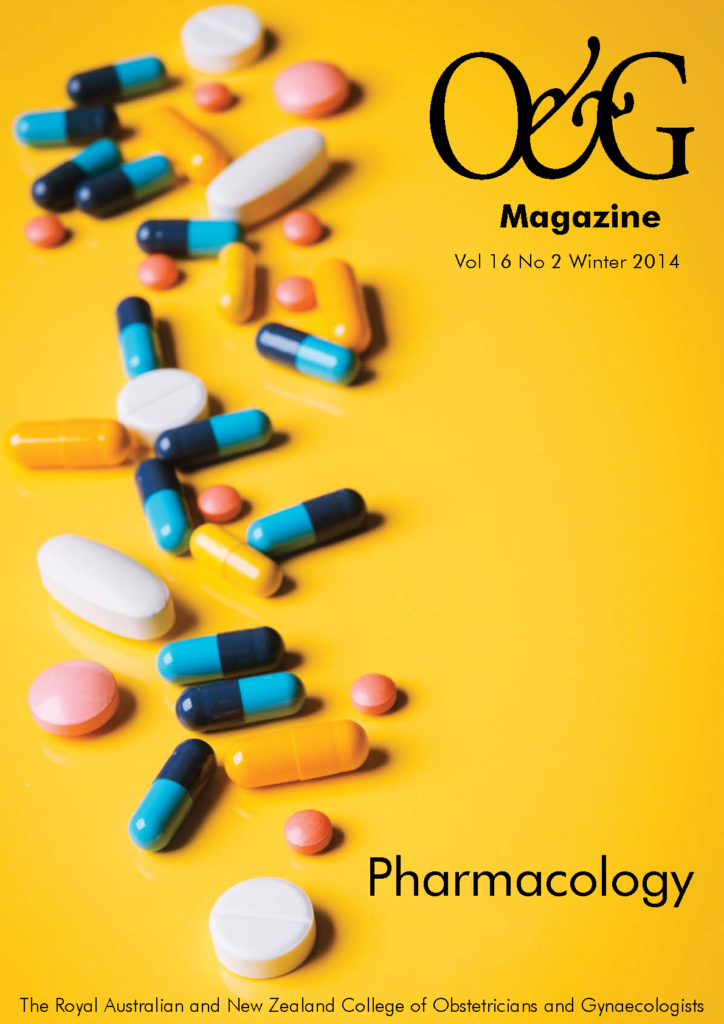I write to you having recently attended an outstanding Indigenous Women’s Health Meeting in Adelaide. Much more needs to be done at all levels, but many Fellows, Diplomates and Trainees are making great contributions to Indigenous women’s health, both in Australia and New Zealand. Indigenous women’s health is embedded in the FRANZCOG Curriculum and it is pleasing to note the plans to further increase online resources and increased incorporation into College assessments.
The highlight of the meeting was the launch of the College’s Reconciliation Action Plan (RAP). The development of a RAP was initiated by the Indigenous Women’s Health Committee in 2012. Aboriginal Fellow Dr Marilyn Clarke chaired a Working Party that, in consultation with Reconciliation Australia, developed a plan that sets measurable and achievable goals, timelines and responsibilities to provide the necessary framework for that change to occur. Marilyn, Dr Jacquie Boyle (Chair of the Indigenous Women’s Health Committee) and the Working Party are to be congratulated on this important development towards ultimately ‘Closing the Gap’ in Aboriginal and Torres Strait Islander women’s health. The RAP is available on the College website at: www.ranzcog.edu.au/womens-health/reconciliation-action-plan.html
Education and training
Examinations
As this has to be written some weeks before publication, my registrars are currently preparing for their May Structured Oral Examinations (SOE). The College is rightly proud that it has been a leader in examination processes such as the rigour employed in the reviewing and workshopping of cases and in our standard-setting procedures. Further positive developments continue and the College will always strive for fair and transparent assessment processes that ensure new Fellows achieve the standard necessary for best-practice outcomes in women’s health.
Examining for the College is one of the most rewarding ways for a Fellow or Diplomate to make a contribution; having a productive exchange with senior colleagues in developing examination questions – while accruing significant CPD points. In encouraging colleagues to become examiners, the response is often: I am a clinician, examining is for academics. Nothing could be further from the truth. The essence of College examinations is assessment by contemporary peers. It is precisely those who describe themselves as a clinician not an academic who are most needed as examiners.
What is the meaning of MRANZCOG?
Awarding MRANZCOG dates back to a time where many of the specialist Colleges had Membership awarded during training, as a staging point on the way to Fellowship. RANZCOG remains one of the very few Colleges to retain a post-nominal (MRANZCOG) that does not meaningfully translate to readiness for specialist practice. During the two years of Advanced (elective) Training, the prospective specialist acquires and enhances the attributes necessary for specialist practice. Within an increasingly defined scope of practice, the Trainee moves from resident (novice) to senior registrar level during the first four years of Core Training and from senior registrar level to consultant specialist (expert) during Advanced Training.
A further confusion is the differing definitions of member and Member. The former includes all Fellows, Diplomates, Trainees, Associate Members, Educational Affiliates and Certificate holders, while the latter refers only to those who have completed Core Training. It could be time for the College to reconsider the awarding of the post-nominal MRANZCOG during training. Like other Colleges, the FRANZCOG would become the primary post-nominal of specialist training in O and G.
Scope of practice
It was to be expected that changes to the FRANZCOG scope of practice under the revised training program would provoke some interest. It is understandably disappointing to many that a future Fellow being awarded FRANZCOG may not necessarily have the same broad scope of practice of a current Fellow. Some change to the scope of practice of all new Fellows is the inevitable consequence of several factors including the reduction in both training hours and training opportunities in comparison to past Trainees.
It would be an undesirable consequence of the revised training program if credentialing committees, hospital administrators or patients developed a view that the new Fellow with an area of special interest became the preferred provider in that scope of practice, ahead of an established Fellow who has a wealth of training, experience, expertise and CPD across a broad scope of practice that includes the relevant field. The College has limited capacity to influence patient choice; however, it potentially could guide a credentialing committee.
Credentialing
Credentialing is defined by the Australian Commission on Safety and Quality in Health Care as referring to ‘the formal process used to verify the qualifications, experience, professional standing and other relevant professional attributes of medical practitioners for the purpose of forming a view about their competence, performance and professional suitability to provide safe, high-quality health care services within specific organisational environments’.
The College is not a credentialing body. Who does what in a hospital or health authority is rightly determined by a local credentialing committee, which considers the circumstances of the applicant in the context of local conditions. However, the College does have a role in assisting the hospital or health service with credentialing.
Firstly, the College has a broad statement that outlines key principles and process matters for credentialing committees, including appropriate persons for membership. The College statement does not give specific directions in the matters that a credentialing committee might consider in making their decision with respect to credentialing for a specific scope of practice: training, currency, continuing professional development and participation in audit of outcomes. Given that other bodies are now making credentialing recommendations, it is perhaps time that the College more specifically gives direction criteria for credentialing.
FRANZCOG in the current training program
The College training programs provide a structure for assessment of satisfactory training by a credentialing committee. Attainment of FRANZCOG is the most important benchmark of training used in determining credentialing in our discipline. It is therefore critical that the College is able to clearly describe the training for every FRANZCOG. For all those that commenced training prior to December 2013, the possession of FRANZCOG means ‘satisfactory training across a generalist scope of practice’. There may also be special interest scopes of practice that can be evidenced by additional training such as subspecialty qualifications or other documentation of satisfactory training in an area of special interest.
FRANZCOG in the Revised Training Program
In contrast to the previous uniformity of the qualification, Trainees who commence training after December 2013 will not all have the ‘generalist scope of practice’. With increasing diversity in training (for example, subspecialisation during Advanced Training), the definition of a ‘common scope of practice’ has become necessary – practice in which all those who hold the FRANZCOG have had satisfactory training. As outlined in my previous report, the broader ‘generalist scope of practice’ will no longer apply to every FRANZCOG.
Credentialing during training
The College has begun to look at credentialing for the Trainee during training. While recognising that varying degrees of supervision are required for all Trainees, hospitals and health services expect some procedures to be performed by Trainees without direct supervision. It is challenging to say that at year level ‘n’, all FRANZCOG Trainees should be able to perform procedure ‘x’ without direct supervision. Even basic labour ward skills create controversy. Some Trainees are reaching year level 3 or 4 of training without the capacity to perform both a simple vacuum and forceps delivery. While each procedure has its passionate advocates, few would argue that a junior Trainee should not be trained in the use of both instruments. The current suggestion before the Education Strategy Committee is that Trainees should be signed off in both techniques of instrumental birth by the end of year level 2. Further discussion will take place through the College committees, but it seems reasonable for a health service to expect that a year level 3 Trainee could accomplish an urgent low instrumental delivery with either forceps or vacuum.
Training beyond FRANZCOG
Imperative in credentialing is a recognition that training does not end with obtaining the FRANZCOG. A review of past clinical performance of the procedure or a proctored for ‘x’ procedures should provide evidence of satisfactory training and competence not implicit in FRANZCOG or other qualifications. A credentialing committee is not performing its duty properly if it only considers qualifications in its assessments.
Currency and CPD
Currency (evidence of continuing to practice in that scope) and CPD are more challenging concepts when it comes to credentialing because they can be misused by vested interests to disenfranchise the generalist – confining specific procedures to a smaller number of clinicians with more limited scopes of practice. If a credentialing committee were to mandate high procedure numbers or a large proportion of CPD in a specific area of practice, a very competent generalist may not be able to reach the specified threshold. As stated in previous reports, there is obviously a place for subspecialisation, but preservation of the generalist is particularly important in countries where the tyranny of distance can mean loss of service provision.
Participation in audit of clinical outcomes
Participation in an audit of clinical outcomes sounds to be the most onerous but should be part of every clinician’s practice. Increasingly, hospitals are including private patients in their clinical audit processes such as perinatal mortality and morbidity or gynaecology morbidity meetings. The Audit of Surgical Mortality is available to all Fellows and a majority are registered.
Colposcopy and ultrasound are two areas where practice may be largely outside the remit of a hospital or health service clinical audit. It is no coincidence that the much discussed C-QuIP is in colposcopy – an area of practice outside the jurisdiction of a hospital credentialing committee. Requests are now coming to the College to improve clinical audit with respect to diagnosis of fetal anomalies on the mid-trimester ultrasound – an area of practice also mostly outside the jurisdiction of a hospital credentialing committee. Of course, most of the latter are not performed by Fellows, but the College may still have a role in the oversight of audit in an area so important to our discipline.
Revalidation
Revalidation can be defined as ‘a regular demonstration by medical practitioners that they remain fit to practice across their chosen scope of practice’. Some view it as a ‘souped-up’ CPD, but the UK model is considerably more than the College’s current CPD program. The Medical Board of Australia (MBA) began a ‘revalidation conversation with stakeholders’ in March 2013. The conversation continues, but increasingly the MBA seems to be looking to the Colleges to develop their own versions of revalidation. Watch this space: it is something that is likely to have a substantial impact on us all.
Women’s Health
The presence of two sets of gestational diabetes mellitus (GDM) diagnostic criteria (ADIPS ad hoc criteria 1998 and WHO criteria 2013) continues to cause significant confusion among obstetricians, midwives, pathologists, physicians and patients. As flagged in this report six months ago, Council has now endorsed both recommendations of the Multidisciplinary GDM Working Party. A single step OGTT at 26–28 weeks is recommended to be implemented by 1 July 2014, and the target for adoption of WHO 2013 diagnostic criteria is 1 January 2015.
It seems likely that physicians will remain passionately divided over the issue, with some demanding yet another RCT when perhaps precious research resources might be directed to those areas where there is a greater paucity of evidence. Nevertheless, the current situation of dual criteria operating in adjacent hospitals is ludicrous and it has become an issue where the College can no longer sit on the fence.
I had previously thought that this would nearly be my last President’s report for O&G Magazine. I now find there are to be quite a few more.






Leave a Reply